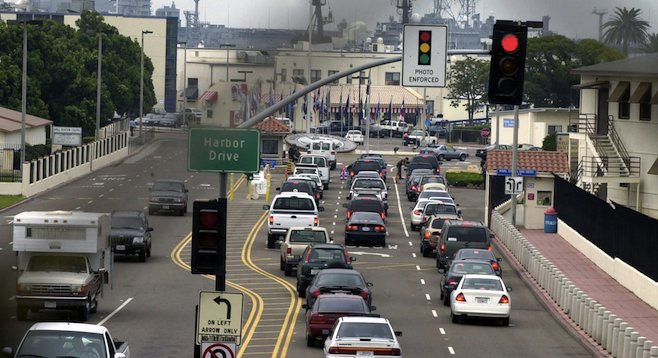 Facebook
Facebook
 X
X
 Instagram
Instagram
 TikTok
TikTok
 Youtube
Youtube

A detailed, annual report on the cost of traffic congestion, lack of road and bridge upgrades, and accidents related to needed safety improvements was released last week.
The nonprofit known as TRIP (“a national transportation research group”) claims San Diego drivers will spend an average of $1886 this year in additional motoring costs, due to congestion and lack of highway construction and maintenance. Wasted time and fuel alone accounted for an estimated $774 in additional costs.
The report found traffic congestion in San Diego worsening, now causing 37 annual hours of delay for the average San Diego County motorist; this means most San Diegans spend more time commuting to work than they receive in vacation time.
San Diego ranks third in the state, behind Los Angeles ($2458) and San Francisco/Oakland ($2206).
Notably, of the five metro areas in the report, Sacramento was the least behind on highway upgrades and maintenance. In the state’s capital, where legislators and Caltrans officials hang out, motorist will pay only $1543 in additional costs.
Total additional cost to California drivers: $44 billion. The group bases its findings on operating costs of a vehicle, traffic crashes, needed improvements, and congestion-related delays.
TRIP, which promotes “policies which are designed to improve traffic conditions,” also reports, “34 percent of the state’s major urban roads and highways are in poor condition, and more than 25 percent of our bridges are structurally deficient or functionally obsolete.”
The report also indicated that the 2012 fatality rate on California’s rural state highway system was four times higher than on our freeways and improved highways.
However, Caltrans director Malcolm Dougherty stated that California motorists are currently enjoying highways that are in the best condition in more than a decade, due to the current stability of transportation funding.
TRIP, based in Washington DC, admits that its funding comes from construction labor unions, highway construction equipment manufacturers, businesses involved in highway and transit engineering and construction, and insurance companies.
Though everyone who drives in San Diego knows about the increased traffic and deteriorating roadways, one could argue that TRIP’s real mission is about jobs: for every $1 billion spent in highway construction, 27,800 jobs come along with it, according to a 2007 analysis by the Federal Highway Administration.


A detailed, annual report on the cost of traffic congestion, lack of road and bridge upgrades, and accidents related to needed safety improvements was released last week.
The nonprofit known as TRIP (“a national transportation research group”) claims San Diego drivers will spend an average of $1886 this year in additional motoring costs, due to congestion and lack of highway construction and maintenance. Wasted time and fuel alone accounted for an estimated $774 in additional costs.
The report found traffic congestion in San Diego worsening, now causing 37 annual hours of delay for the average San Diego County motorist; this means most San Diegans spend more time commuting to work than they receive in vacation time.
San Diego ranks third in the state, behind Los Angeles ($2458) and San Francisco/Oakland ($2206).
Notably, of the five metro areas in the report, Sacramento was the least behind on highway upgrades and maintenance. In the state’s capital, where legislators and Caltrans officials hang out, motorist will pay only $1543 in additional costs.
Total additional cost to California drivers: $44 billion. The group bases its findings on operating costs of a vehicle, traffic crashes, needed improvements, and congestion-related delays.
TRIP, which promotes “policies which are designed to improve traffic conditions,” also reports, “34 percent of the state’s major urban roads and highways are in poor condition, and more than 25 percent of our bridges are structurally deficient or functionally obsolete.”
The report also indicated that the 2012 fatality rate on California’s rural state highway system was four times higher than on our freeways and improved highways.
However, Caltrans director Malcolm Dougherty stated that California motorists are currently enjoying highways that are in the best condition in more than a decade, due to the current stability of transportation funding.
TRIP, based in Washington DC, admits that its funding comes from construction labor unions, highway construction equipment manufacturers, businesses involved in highway and transit engineering and construction, and insurance companies.
Though everyone who drives in San Diego knows about the increased traffic and deteriorating roadways, one could argue that TRIP’s real mission is about jobs: for every $1 billion spent in highway construction, 27,800 jobs come along with it, according to a 2007 analysis by the Federal Highway Administration.
Comments